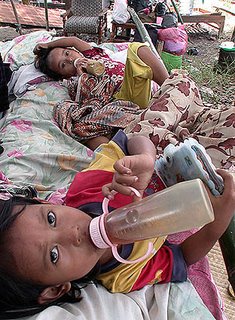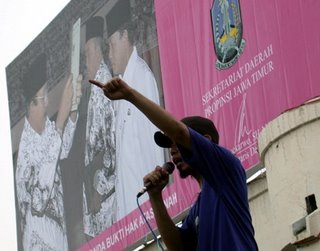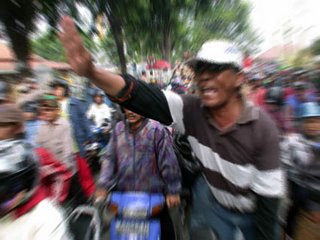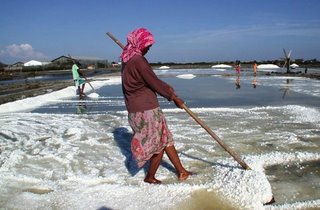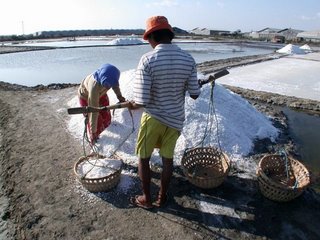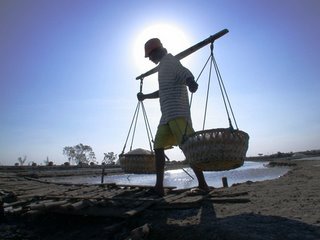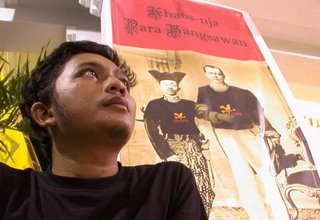The mudflow disaster in Porong, Sidoarjo, East Java, has implicated many parties, not only Lapindo and the Bakrie family, but also the country's largest Muslim organization Nahdlatul Ulama and some media companies. The Jakarta Post's Riyadi Suparno, assisted by our journalists in East Java Indra Harsaputra and ID Nugroho, investigated the intricate relationship of those parties in the handling of the disaster. What follows are their reports. The million dollar question is: which company has been the most talked about in East Java over the past two months? The answer is Lapindo Brantas Inc., a company controlled by the Bakrie family. This oil and gas company became so popular -- or unpopular -- by triggering the uncontrolled gushing of hot mud in Porong, Sidoarjo, East Java.
The mudflow, which began slowly on May 29 -- which is why the company initially played it down -- is becoming bigger each day. It now spouts 50,000 cubic meters of hot mud a day, submerging rice fields and four villages, and making 10,000 villagers homeless.
The problem grew when the mud submerged the turnpike linking Surabaya and the eastern part of East Java. The closure of the turnpike caused massive traffic jams, delaying travel and deliveries.
When the turnpike was elevated, and protected with sand-and-stone walls, the mud breached the walls in other areas, flooding more villages, and even closing the Porong main road and railway link.
The villagers have nothing kind to say about Lapindo. They spell out their displeasure for everyone to see in the graffiti on their walls, through demonstrations and in some cases by forcefully breaching the walls holding back the mud.
They have also demonstrated on the main street of Porong, demanding that Lapindo's license be revoked and its executives prosecuted.
Initially, Lapindo claimed it was not responsible for the mudflow because the mud was not gushing out from its wells. However, Lapindo's partner in the Brantas block accused Lapindo of "gross negligence" for not setting casing on at the depth of 8,500 feet at Banjar Panji I well, where the mudflow originated.
Although the exact cause of the mudflow is not yet known, all parties are pointing the finger at Lapindo. The police were quick to question those involved in the drilling activities that caused the uncontrolled mudflow, and named nine people suspects.
They include Imam Agustino, the president of Lapindo; Nur Rochmat Sawulo, drilling share service vice president of PT Energi Mega Persada, a shareholder in Lapindo; and Yenny Nawawi, the president of PT Medici Citra Nusa, a contractor of Lapindo. The other six are drilling executive staff. All suspects could face between five and 15 years' jail if found guilty. But the police stopped there. No progress has been reported.
In addition, a number of organizations have planned to launch a class action against Lapindo, on behalf of the victims. They include the country's largest Muslim organization, Nahdlatul Ulama (NU), and the East Java office of the Indonesian Forum for the Environment (Walhi).
But the NU is not entirely sure it will go ahead with the class action because, according to an NU activist, NU leaders have received money from the Bakrie family, which essentially owns Lapindo. (See sidebar: NU dragged into the mudflow dilemma).
"Just call it a bad day for us. This is indeed the risk that any drilling entails," Imam Agustino said recently, referring to the May 29 accident.
Lapindo itself has been trying hard to solve the multifaceted problems. The company has spent billions of rupiah on efforts to stop the mudflow, manage the growing amount of mud and to compensate the victims.
It established three teams to handle the problems. The first team, led by Lapindo itself, is trying to find ways to stop the mud gushing. Despite its efforts, however, it has not been able to stop the mudflow. (See sidebar: No end in sight to stop the mud gushing).
The second team, led by the State Ministry for the Environment, is dealing with the management of the hot mud, which keeps increasing every day. The team has decided to separate the water from the solid substances in the mud, treat the water and dump it in the sea. As for the solid substances, no decision has been made. (See sidebar: What to do with the mounting sludge).
The third team, led by the Sidoarjo administration, is addressing social problems, including providing shelter for the victims, distributing assistance and finding permanent solutions for the victims, either by relocating them to safer places or compensating them for their losses so they can rebuild their lives.
To contain the impacts of the disaster, Lapindo is spreading money among a number of institutions, including the local military to help build the embankment and evacuate the victims and the Sidoarjo administration which is trying to meet victims' immediate needs as well as financing needs of groups that are assisting the victims.
As things progress, however, the money has worked its way in to the pockets of some environmental activists and non-governmental organizations in the regency, so that they will be more cooperative and not so "vocal," according to one activist.
"They are operating so cleverly, leaving no stone unturned. Most parties will get assistance so that they will not be so vocal against Lapindo," said environmental activist Satrijo Wiweko.
He suspected that some media in East Java had also received "assistance" so that their reports would not be too hard on Lapindo and local administrations.
Lapindo's East Java general manager Rawindra denied the accusation, saying that it worked in cooperation with all parties, with the Sidoarjo administration as the central point of coordination.
Rawindra refused to respond to the accusations, saying that the company would rather focus its attention on helping the victims. To anticipate the coming of the fasting month, the company is helping the victims relocate from Porong market, where they have been living for the past two months, to rented houses.
The company has given each family Rp 5 million for two years' rent and Rp 500,000 for moving costs, with a Rp 300,000 monthly food allowance per head per month for the next six months.
A number of villagers, however, describe the compensation as inadequate. Mahmudah, Renokenongo's village chief, acknowledged that almost half of the mudflow victims in his area had refused the allowances.
"They have not yet accepted the money and I don't blame them because it's their right to decide," Mahmudah told The Jakarta Post.
Some of those turning down the compensation have staged a protest at the Pasar Baru refugee camp and a demonstration on Porong's main road. "Many things go beyond the value of money, such as the threat hanging over our heads that the hot mud could burst out anytime and flood our homes," said a refugee in a protest rally.
Tough slog for students in muddy Sidoardjo Windiarti Rahayu is not afraid of hard work but lately her enthusiasm for school has been waning. In fact, the 13-year-old student at SMPN 2 Porong junior high school in Sidoarjo, East Java, has made a habit of dropping off in class and passing in late homework.
"I feel sleepy all the time since we were forced to move out of our school because of the mudflow," she told The Jakarta Post on Monday. The hot mudflow, which gushed out of Lapindo Brantas Inc. gas prospecting site, has continued to submerge dozens of houses, hectares of rice fields, several factories and schools since the problem began on May 29.
From a distance, only the roof of the junior high school is visible beyond the mudflow, which has reached a height of six meters. The school closed in mid-June after all 18 of its classrooms were submerged.
Its students are now studying three kilometers away, at SDN Renokenongo elementary school. However, with three students to a desk, it is clear the school is not really big enough to accommodate the junior high school's 694 students.
Information technology and English classes have been canceled, for the time being, because of the shortage of space and facilities. "I am trying hard to stay focused but the situation doesn't inspire us to work," Windiarti said.
She said she could not study or do her homework as she was living in a shelter at Porong market. "We can't study because it's so crowded and there's barely enough light to see. I can't get through my homework and the teacher punishes me. That's just the way it is now."
She returned briefly to her home in Siring village but quickly left again for the shelter after a temporary pond overflowed, inundating her house and sweeping away her books. Now, Windiarti makes do with sharing friends' books.
The junior high school's principal, Kayis, said teachers had been doing all they could to limit disruptions to the children's education. He said some teachers were spending a lot more on transportation to reach the elementary school.
"We've asked Lapindo to build us a new school. It's not safe here. The mudflow is still threatening the surrounding areas."
Three other elementary schools in Porong -- SDN Siring 1 and 2, which have more than 700 students in total; and SDN Kedungbendo 2, which has 300 students -- have also been affected by the mudflows.
When one of the ponds that was built to retain the mudflow in Jatirejo village broke apart Thursday, the schools sent students home for two days.
Classes resumed at that school Monday, but Siring's students had to move out of their school, while students at Kedungbendo remained, despite having to withstand the foul smell emanating from the mudflow.
East Java Education Council chairman Dhaniel Rosyid said Lapindo should build a new school, located far from the mudflows. "This is Lapindo's responsibility. Education should top its priorities, apart from working to stop the mudflow and relocate residents."
He urged the central government to make regulations that prohibited mining activities near residential areas and schools.
Lapindo hires pros to clean up its image Lapindo Brantas Inc., a unit under the Bakrie family, has responded to the unprecedented ecological disaster originating from its gas well by going on a public relations charm offensive aimed at cleaning up its image.
For the most part, the company's efforts seem to have paid off. In the first month of the disaster in Sidoarjo, Lapindo was receiving most of the blame for the mudflow. Both the media and the public were accusing the company of bringing misery to thousands of people with its drilling activities.
Seemingly sealing the company's fate, several of its executives were named as suspects by the police for negligence leading to the mudflow.
However, as the disaster entered its second month a different image of Lapindo was being projected, at least in the media. Now Lapindo was being painted as a responsible company that was taking care of the victims of the mudflow and providing them with compensation, all the while making every effort to stem the flow of mud.
This drastic change no doubt has much to do with the company's hiring of professional image builders and the strong political clout of its main shareholder, a company linked to the Bakrie family, including Coordinating Minister for the People's Welfare Aburizal Bakrie.
"If Lapindo had no political clout, it would have been finished in a matter of weeks because of this mudflow brouhaha," said Henry Subiyakto, a lecturer at Airlangga University in Surabaya and also head of the Surabaya Media Consumer Foundation.
Among the image specialists hired by Lapindo, or its shareholder, are several former journalists and media specialists. Henry says he was approached about joining the team responsible for improving Lapindo's image and that of the Bakrie family.
This team of professionals has made a concerted effort to polish Lapindo's image, lobbying owners of media companies in East Java and journalists covering the mudflow story, and also helping set up a media center in Sidoarjo town hall.
The media center provides daily updates about the handling of the mudflow and its victims. It must be said that the center is fairly objective, covering demonstrations by victims and their demands for compensation.
The center provides free Internet access, telephone use and printing and photocopying facilities for members of the media. Not only that, according to one source, the media center also provides a "supplemental income" for journalists.
Lapindo denied that it is financing the media center. But one source said that while the company did not finance the center directly, it channeled the money through the local government.
East Java Information and Communication Agency (Infokom) head Suwanto acknowledged the role of Lapindo in the establishment of the media center, but denied that the company provided any financial support for its operation.
"Lapindo only provides photocopy machines, paper and lunch. Everything else is financed by Infokom East Java," Suwanto told The Jakarta Post. He added that the center was established on a direct order from East Java Governor Imam Utomo.
Victims can't afford to forget mud "The dam's breaking... it's collapsing...," a resident of Siring, Porong, Sidoarjo, shouted as he noticed hot mud flowing toward his house last week.
Hundreds of people living near the walls holding back the mudflow were sent scurrying in fear to Porong's main road, effectively blocking the road linking Surabaya and the eastern part of East Java.
Dressed in rags and mud stained, villagers of all ages raced to reach the road, seen as a safe mud-free place, clutching anything worth salvaging like important documents, school uniforms and kitchen utensils. Parents carried their children on their backs, willing them to stay calm.
The walls, which are holding back more than four million cubic meters of mud have been collapsing here and there as they are not strong enough to contain the increasing amount of mud, estimated at an additional 50,000 cu m per day.
Damage to the walls has panicked the community living near the huge mud ponds, which now cover 180 hectares, and may soon double to 360 hectares.
Locals are worried about their safety and anxious over not only blistered skin due to the heat of the mud, which has reached 60 degrees centigrade, but also damaged property resulting from hot mud inundation.
"All we can do now is to save ourselves and our most prized belongings. We would have carried our whole house had we been able to pull it up," said Suwarno, a Siring villager.
Though he originally refused to take refuge because he was confident in the capabilities of the joint team handling the mudflow, doubt began to set in when he saw the walls were higher than his house. Then the dam started cracking and hot mud flowed into Siring.
There was also an atmosphere of fear in the villages of Jatirejo, Ronokenongo and Kedungbendo as their dams developed fissures. In Jatirejo, the dark gray mud spread extensively over places previously unaffected. Locals were particularly worried when it crept over the railway tracks running through the village. "The mud could cause a train accident," Jatirejo villager Haryadi pointed out.
In Jatirejo, dozens of cows owned by the Agil Hasan Al Syadili Islamic boarding school had to be evacuated for fear that dehydration would kill them.
"The cows, which were one of the school's main income sources can't be milked for the moment," school principal Gus Maksum Zubair told The Jakarta Post. The school, which has about 200 students, also found its 2.5 hectares of paddy fields flooded by hot mud.
"Our students have been sent home for a while. Some staff members have stayed behind to take care of the school," Gus Maksum said.
More than 9,000 displaced people from the four inundated villages are now being accommodated in Pasar Baru Porong, Sidoarjo, five kilometers from the hot mud source.
The neatly arranged barracks, originally designed as a public market and terminal, are increasingly packed with the growing number of refugees moving in from mud covered areas.
The 9,000 refugees have to share 282 kiosks in Pasar Baru, each measuring four by six meters with five families and their possessions, separated from one another only by curtains.
To shower, they have to wait their turn as there are only 109 bathrooms available.
This situation has gone from bad to worse as there is no certainty about the fate of the mudflow victims, while the mud continues gushing, ruining all that it touches.
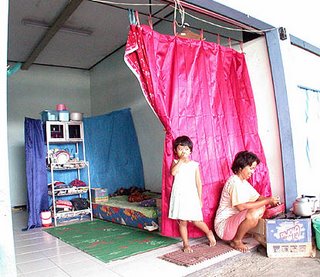 Yuliana Thomas could only relish the memory of past Christmas celebrations, since the victim of the Sidoarjo, East Java mud disaster is now living in makeshift shelter at the Porong market.
Yuliana Thomas could only relish the memory of past Christmas celebrations, since the victim of the Sidoarjo, East Java mud disaster is now living in makeshift shelter at the Porong market.

